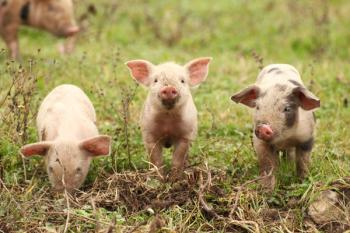
Examining Pathogen-Induced Morphomolecular Divergence in Tumor-Derived Cells with Raman Spectroscopy: An Interview with Clara Craver Award Winner Ishan Barman
The Coblentz Society created the Clara Craver Award to recognize young individuals who have made significant contributions in applied analytical vibrational spectroscopy. The work may include any aspect of infrared (IR), terahertz (THz), or Raman spectroscopy in applied analytical vibrational spectroscopy. This year’s recipient, Ishan Barman, is an Associate Professor in the Department of Mechanical Engineering at the Johns Hopkins University with joint appointments in Oncology and Radiology and Radiological Science.
The Coblentz Society created the Clara Craver Award to recognize young individuals who have made significant contributions in applied analytical vibrational spectroscopy. The work may include any aspect of infrared (IR), terahertz (THz), or Raman spectroscopy in applied analytical vibrational spectroscopy. This year’s recipient, Ishan Barman, is an Associate Professor in the Department of Mechanical Engineering at the Johns Hopkins University with joint appointments in Oncology and Radiology and Radiological Science. The award is to be presented at the annual SciX conference, which will be held this year from October 8 through October 13, in Sparks, Nevada. As part of an ongoing series of this year’s SciX conference honorees, Ishan spoke to us about his recent work combining Raman spectroscopy and quantitative phase microscopy to examine the morphomolecular changes induced by Bacteroides fragilis toxin (BFT) in breast cancer cells.
The Clara Craver award will be presented at the annual SciX conference, which will be held this year from October 8 through October 13, in Sparks, Nevada. As part of an ongoing series of this year’s SciX conference honorees, Ishan spoke to us about his recent work combining Raman spectroscopy and quantitative phase microscopy to examine the morphomolecular changes induced by Bacteroides fragilis toxin (BFT) in breast cancer cells.
In a recent paper (1), you discuss how you and your associates combined Raman spectroscopy and quantitative phase microscopy (QPM) to investigate the changes in cancer cells induced by microbiota-secreted metabolites (B. fragilis toxin). What motivated you to use Raman spectroscopy over other spectroscopic techniques?
Vibrational spectroscopy is unique amongst experimental techniques in that it can be performed in near-physiological conditions and explore dynamics on timescales ranging from milliseconds to days. Specifically, Raman spectroscopy was chosen for its unique ability to provide detailed molecular information without the need for labels or stains. Unlike other spectroscopic techniques, Raman spectroscopy is non-invasive and can directly analyze the molecular composition of cells and tissues in their native state. This made it an ideal choice for investigating the subtle changes induced by microbiota-secreted metabolites in cancer cells.
This research was conducted in pursuit of introducing a label-free, multimodal technique to the cancer−microbiota research community in hopes of accelerating progress in understanding the role of microbiota in cancer cell molecular composition, morphology, and invasiveness. Just how important is this technique? What, if anything, is currently being used to carry out similar research?
The technique we employed is important as it offers a non-invasive, label-free approach to studying the interactions between microbiota and cancer cells at the single-cell level. Currently, many studies in this area rely on traditional assays and labeling techniques that can be invasive and alter cell behavior.
One of the principal advantages of our technique is its non-invasive nature. Traditional assays used in cancer-microbiota research often involve the introduction of exogenous labels or dyes into cells, tissues, or organisms. These labels can potentially alter the behavior of cells and may not accurately represent the natural state of the biological system. In contrast, our label-free approach allows us to observe and analyze cells in their native state without perturbing their environment. This is critical for obtaining biologically relevant insights.
Furthermore, our technique enables the study of interactions between microbiota and cancer cells at the single-cell level. This level of granularity is essential because cancer is a highly heterogeneous disease, and even within a single tumor, there can be significant variation in cell behavior. By analyzing individual cells, we can better understand the diversity in responses to microbiota-secreted metabolites and how these interactions contribute to tumor progression.
We further employed a multimodal approach by combining Raman spectroscopy and quantitative phase microscopy. This combination allows us to capture both morphological and molecular information from cells. By integrating these two types of data, we gain a more comprehensive view of how microbiota influence cancer cell behavior. This approach offers a holistic understanding that traditional methods lack.
How does machine learning factor into your work?
Machine learning plays a crucial role in our research by helping us analyze complex data and identify subtle differences between cells. Raman spectroscopy generates intricate data that includes spectral information from various biomolecules within cells. These spectra can be highly detailed, containing numerous peaks and subtle variations. Machine learning algorithms are employed to handle this complexity efficiently. They assist in identifying patterns, trends, and differences within the data that might be challenging for human analysts to discern.
Crucially, machine learning brings precision and objectivity to our analysis. It eliminates potential biases that can arise from manual interpretation of spectral data. The algorithms operate consistently and objectively, ensuring that the classification is based solely on the features present in the spectra. This objectivity enhances the robustness and reliability of our findings.
In this work, machine learning also assists in assessing the long-term effects of BFT exposure on cancer cells. By comparing spectral data from different groups, including cells before and after tumor growth, machine learning algorithms help us recognize and quantify the persistence and potential enhancement of BFT-induced biomolecular changes.
Please summarize your findings.
By leveraging this multimodal platform featuring Raman spectroscopy and quantitative phase microscopy, our research revealed a "BFT memory" effect, where short-term exposure to microbiota-secreted metabolites had lasting effects on cancer cell behavior. We found that the BFT-induced biomolecular changes not only persisted but were potentially enhanced after tumor growth, highlighting the significance of microbiota-cancer cell interactions in shaping cancer progression.
This discovery has significant implications for understanding the long-term impact of microbiota on cancer progression. It suggests that even transient interactions with microbiota can influence the course of the disease, which still remains poorly understood. By providing a more accurate and comprehensive understanding of these interactions, we can potentially identify novel therapeutic targets and strategies for managing cancer in the context of the microbiome.
Were there any limitations or challenges you encountered in your work?
While our study provides valuable insights, it is essential to acknowledge certain limitations. One limitation is that our research focused on a specific microbiota-secreted metabolite (BFT), and there are many other metabolites and interactions to explore. Additionally, the complexity of the microbiome and its influence on cancer is still not fully understood, and our study represents a preliminary step in this direction. Another challenge was dealing with the inherent heterogeneity of cellular responses. Cancer cells are known for their variability, and even within a single cell population, individual cells may respond differently to external stimuli. The number of samples and cells analyzed in our study may be considered relatively small in the context of the extensive heterogeneity present in cancer cell populations. While our findings were robust within the scope of our study, a larger dataset could provide even deeper insights into the microbiota-cancer cell interactions.
Can you please summarize the feedback that you have received from others regarding this work?
The feedback from our peers and the scientific community has been overwhelmingly positive and validating. Our label-free approach combining spectroscopy, microscopy, and machine learning has garnered significant interest and recognition. Our observation of the "BFT memory" effect has sparked discussions and inquiries for potential collaborations. Researchers have also shown keen interest in applying our techniques to their own microbiota-related studies, demonstrating the broader impact and relevance of our work within the field of cancer-microbiota research.
What are the next steps in this research?
Our next steps involve expanding our research to explore the broader spectrum of microbiota-secreted metabolites and their effects on cancer cells. We aim to further validate our findings in different cancer models and investigate the specific molecular mechanisms underlying these interactions. Additionally, we plan to apply our technique to clinical samples, potentially paving the way for diagnostic and therapeutic advancements.
What does your being named the recipient of the Craver Award mean to you professionally? Personally?
Receiving the Craver Award is a significant milestone in my career as a spectroscopist. It serves as a recognition of the dedication and innovation that our team has brought to the field of applied analytical vibrational spectroscopy. This recognition is a source of motivation to continue making meaningful contributions to science and to inspire the next generation of researchers.
On a personal level, receiving the Craver Award is a deeply gratifying and humbling experience. It signifies the culmination of years of passion, curiosity, and commitment to scientific exploration. It brings a sense of pride not only to me but also to my team and my mentors who have supported and believed in our work.
References
(1) Liu, Z.; Parida, S.; Wu, S.; Sears, C. L.; Sharma, D.; Barman, I. Label-Free Vibrational and Quantitative Phase Microscopy Reveals Remarkable Pathogen-Induced Morphomolecular Divergence in Tumor-Derived Cells. ACS Sens. 2022, 7, 1495−1505. DOI:
About the Interviewee
Newsletter
Get essential updates on the latest spectroscopy technologies, regulatory standards, and best practices—subscribe today to Spectroscopy.




